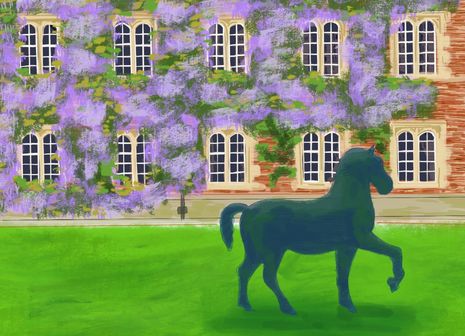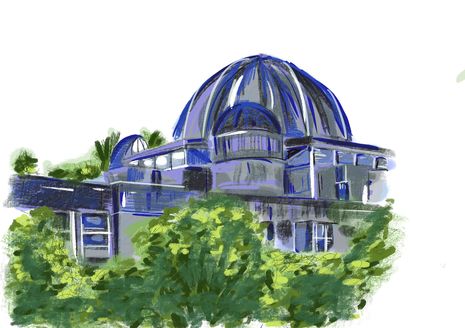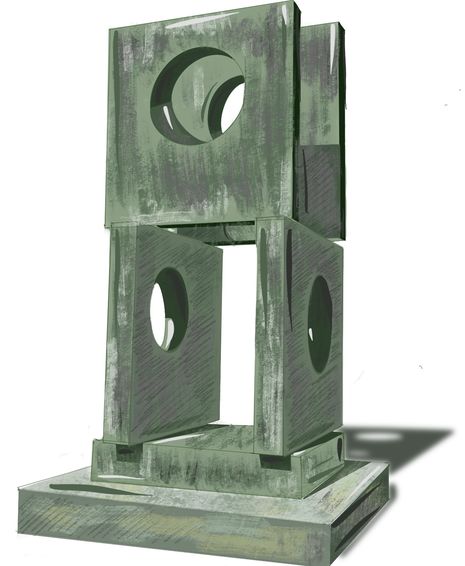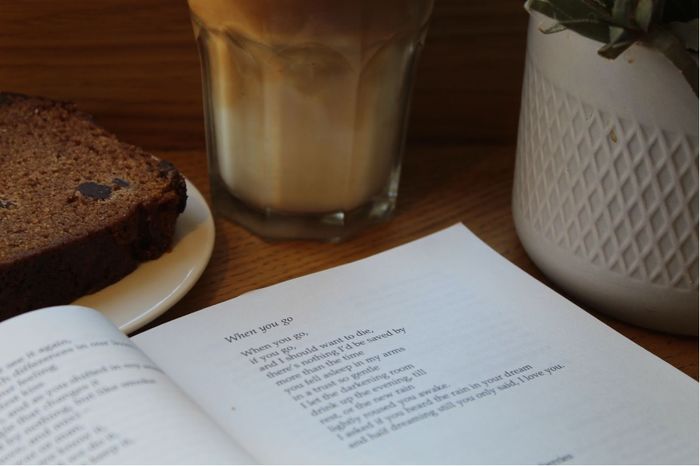Art close to home
Cambridge’s wealth of art isn’t confined to museums and galleries: across the colleges, corridors are canvases and gardens become galleries. There’s plenty to see on your doorstep.

Girton College
Walk through Girton’s winding brick corridors, and feast your eyes upon the ‘People’s Portraits’, an art exhibition that represents people ‘from all walks of life.’ Over 60 portraits cover the college walls, capturing subjects like ‘The Boxer’ a man who slouches forward towards the spectator, boxing gloves discarded by his side. Wander down from plodge, through schlub (the social hub) and along the arched hallways to the library to follow this wide range of portraits from start to finish. If looking for some more art while there, make sure to venture into Girton’s dining hall, unique in its display of exclusively female portraits, a refreshing change from the male dominated paintings in many Cambridge college dining halls. (See if you can spot the portrait of Baroness Hale)
Queens’ College
College halls tend to be adorned with portraits of alumni and masters, commissioned by established artists and occupying prominent spaces within college. Queens’ college integrates students into the tradition of displaying art in common spaces, most notably through the Queens Arts Festival, an annual exhibition displayed in the West gallery. The gallery is nestled above the Fitzpatrick Hall, a multipurpose theatre and part of the Cripps building. Students accommodated in the 200 surrounding rooms are only a stone’s throw from the gallery, and need not set foot outside as the display which can be accessed through ‘gyp hopping’ along corridors. The space is bright, airy, and - in true Cambridge fashion - contains several workspaces. The event is the largest of its kind in Cambridge, curated by students and featuring work from Cambridge University, The Cambridge School of Visual and Performing Arts, and Anglia Ruskin. The theme of the current exhibition is ‘Bricolage: you are what you make’, which spotlights an impressive range of mediums from photography and paintings, to sculpture, zines and poetry.
Jesus College
Jesus is home to a permanent display of 29 sculptures, which can be found dotted across the sprawling college grounds. Pick up an illustrated map showing the sculpture locations from the Porters Lodge, and weave your way from Barry Flanagan’s ‘Bronze horse’ all the way around to Henry Moore’s ‘Leaf Figure.’ Edoardo Paolozzi’s ‘Daedalus on Wheels’ is particularly interesting for the Classicists among you, with the sculpture’s wheeled platform and geometric body parts being a nod to Daedulus’s role as a fellow sculptor in Greek mythology.
Clare College
Clare’s art-inspired gardens were designed by college fellow Nevill Willmer with landscape paintings and colour vision in mind. Though the Fellow’s Garden is closed until 2024, there are a number of other sylvan delights to indulge in. The River Beds were intentionally planted with bright coloured flowers in the foreground, and softer pastel shades in the background, in order to mimic the hazy blue horizons of landscape paintings. Similar colour vision was used by Willmer in the yellow and blue border of flowers planted from the Pond Garden to the riverbank. Willmer was known to lead colleagues into the Garden in early evenings, so as to show how the blues became lighter and the yellows darker as twilight descended. Of equal interest is the Sunken Garden inspired by Willmer’s trip to Pompeii, and the bold colours of the Tropical Garden.
Murray Edwards College

Murray Edwards offers a refreshing alternative to the traditional medieval Gothic and Neoclassical architecture of the central colleges. The iconic dome and college buildings were designed by architects Chamberlin, Powell and Bon, famed for their design of London’s Barbican Estate. This Brutalist architecture is complemented by the contemporary Women’s Art Collection, with works by prominent women artists interspersed throughout the concrete complex. Attempting to redress the gender imbalance presiding in so many museums and galleries, the collection, unrivalled in Europe, celebrates the role of renowned and lesser-known women artists in art movements since the 1950s. Medwards students needn’t stray far to be immersed in the collection: undergraduates lucky enough to live in Orchard Court can glance out of their bedroom windows to view sculptures by Barbara Hepworth or Naomi Press planted on the lawn. A short trip from the library to the buttery becomes a walk-through exhibition, along corridors adorned with an eclectic mix of drawings, paintings, prints and photographs, to the dining hall in the dome, where you can enjoy your Saturday brunch surrounded by majestic canvases including Paula Rego’s Inês de Castro, painted for the Women’s Art Collection’s 60th Anniversary.
Newnham College
Those bits of gold and silver metal hanging from the ceiling at The Iris? That’s actually an art installation, or more specifically, a light sculpture, known as the ‘Arc of History.’ Created by the design studio ‘Haberdashery’, the sculpture is made up of pages from the College archive which have been recreated in brass and steel. Twenty pieces were selected from the archive and repeated throughout the sculpture, amongst which being a letter home by Rosalind Franklin, a Newnham student and co-discoverer of the structure of DNA, and a study on the ‘Health Statistics of Women Students’ (The author, Eleanor Sidgwick, concluded that ’there is nothing in a university education at all specially injurious to constitution of women, or involving any greater strain than they can ordinarily bear.) Settle down with a flat white, and gaze up at the light sculpture, a visual reminder of the college’s history of women’s education.
Trinity Hall College
For something a little more non-conventional, step into Trinity Hall’s Dining Hall where a wall-based artwork The Willow will Submerge in Time contains plants and soil from the River Cam. The piece is a nod to the college’s location by the water’s edge, but also to Xu Zhimo’s famous poem ‘Second Farewell to Cambridge’, in which he describes a ‘golden willow on the bank of the Cam.’ Follow this with a trip to the chapel, where, on a more traditional note, Manzuoli’s Salutation (c.1570) lives above the altar on permanent loan from the Fitzwilliam museum. Depicting the pregnant Mary’s visit to Elizabeth, mother of St John the Baptist, the work is attributed to the Counter-Mannerism movement in Florence, and definitely worth a visit.
Churchill College

The threshold of Churchill College is marked by a seven-bar aluminium pivoting gate. Aside from providing an imposing entrance to the college, this striking sculpture by Geoffrey Clarke sets the precedent for the vast sculpture collection that interacts with the college surroundings. Set over 42 acres, Churchill’s divisive modernist architecture and sprawling grounds are dotted with sculptures by artists such as Nigel Hall, Dhruva Mistry, and Peter Lyon. Sculptures are carefully positioned to complement the brutalist design – clean lines, abstract forms and often angular compositions resonate with the geometric structure of the college buildings. Harsh spikes and corners on buildings and sculptures, such as Denis Mitchell’s Past, Present, Future, are softened by the surrounding gardens and plants to create a unique collegescape. Sculptures also function as visual anchors amidst expansive lawns and walkways, such as Barbara Hepworth’s towering Four-Square (Walk Through).
 News / Cambridge postgrad re-elected as City councillor4 May 2024
News / Cambridge postgrad re-elected as City councillor4 May 2024 News / Gender attainment gap to be excluded from Cambridge access report3 May 2024
News / Gender attainment gap to be excluded from Cambridge access report3 May 2024 News / Some supervisors’ effective pay rate £3 below living wage, new report finds5 May 2024
News / Some supervisors’ effective pay rate £3 below living wage, new report finds5 May 2024 Comment / Accepting black people into Cambridge is not an act of discrimination3 May 2024
Comment / Accepting black people into Cambridge is not an act of discrimination3 May 2024 News / Academics call for Cambridge to drop investigation into ‘race realist’ fellow2 May 2024
News / Academics call for Cambridge to drop investigation into ‘race realist’ fellow2 May 2024




